| Luc & Hilde Sioen - Provavelmente um dos melhores Grande Meio Fundistas da actualidade |
08-06-2018 |
Artigo em Inglês retirado "De Duif Chronicals" pode ler o original em www.deduif.be ou em www.syndicatelofts.com
Anda tudo atrás das modas e outros fazem a moda....lembrem-se deste nome....Luc Sion e a esposa Hilde.
Resolvi recordar este artigo depois de na 1ª Prova Nacional Bourges de 2018 eles marcarem: 5º-9º-21º-22º-25º-40º-44º-82º entre 20.280 pombos
2015 : 17 x 1º
2016 : 15 x 1º
2017: 15 x 1º
Artigo de grande qualidade da autoria de : Michel Bommerez
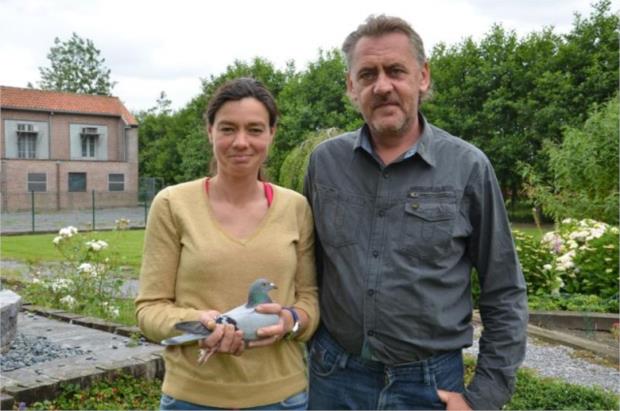
PART I: The eventful pigeon career of Luc Sioen
Hilde who? I hear you asking. Indeed, Hilde is usually mentioned in the same breath as her husband Luc Sioen. But although she doesn’t race under her own name, we can certainly add her full name to the chronicles of the pigeon sport as someone who has ‘it’ in the fingers. Otherwise you wouldn’t win five big nationals under your own steam, otherwise you wouldn’t ‘park’ six pigeons in the first seven national out of La Souterraine over the three categories. “Hilde can do things with the pigeons that I can’t,” Luc Sioen modestly confesses. Luc himself may have won international St. Vincent with the ‘Il Grillo’, but “Hilde has a special connection with her pigeons”, Luc continues, “The pigeons like her, they are happy when she comes into the loft, and I’m sure that it’s her the birds fly home for…” Hilde Vanoverschelde is a natural, that much is clear. But first we want to tell you the story of her husband Luc Sioen.
Gerard Sioen
We can’t tell the pigeon story of Luc Sioen without telling the story of his father Gerard as well. Gerard, who died in 2007, had been one of the best pigeon fanciers of the area for most of his life. All this time, he stayed true to the speed races, with a little bit of middle-distance for good measure, and he stayed true to his principles: pigeon racing of the last century you could call it. Gerard only kept a few pigeons, had a razor sharp knife and went almost never to a vet. But he had good quality pigeons, and to these he also stayed true for his entire life. These pigeons were not necessary big names, but they were all-rounders. Luc tells us: “I always had other pigeons, but once in a while I added a few of my father’s birds, and these could always race long-distance with ease. They were strong pigeons”. “Was there also a touch of Bostyn in these?” I wanted to know. “No,” Luc resolutely answered, “Bostyn is a completely different story.” Most readers will undoubtedly know that the late Pol Bostyn was also a resident of Moorslede. “Bostyn lived barely half a kilometer from us,” Luc told us, “but father knew him more from the flax cultivation than from the pigeons. You must know: Pol Bostyn, was Champions League, long-distance and extra long-distance, while my dad played more in the ‘second division provincial’ team. So in pigeon racing, their paths almost never crossed.”
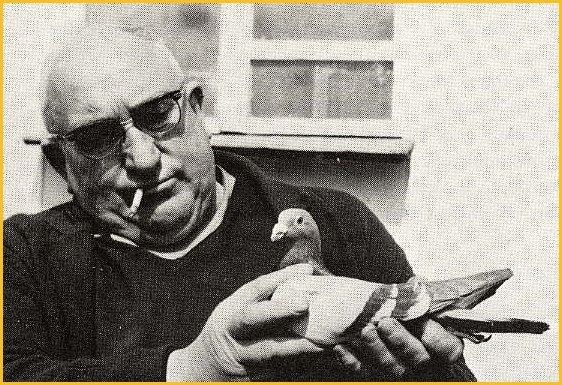
At the time that Luc Sioen as young man met Pol Bostyn, Pol was already on the way out. This didn’t preclude Bostyn from making a great impression on Luc Sioen, who justly calls him an ‘important figure’ in his life…
Even so Pol Bostyn
Luc Sioen has had the pigeon bug from very early on. As a young boy of ten or eleven years old, he was sometimes allowed to accompany his father, and of course he got some attention from the other club members. In 1977 for instance, a friend of his father’s gave him a young pigeon. Normally, that pigeon would go into the loft with the other young pigeons, but Gerard and Luc thought otherwise: it was a pigeon for Luc, and therefore Luc would look after it himself. He was given the use of a very small compartment, and the pigeon was trained. And you can guess what happened: it became a super pigeon and straight away it flew first in the speed races twice in a row. “Yes, that’s when you are hooked for life of course,” Luc sighs with a broad smile. But we were talking about Bostyn.
One day, a strange young bird sat among Luc’s small team. “Nowadays, I would chase that bird out as quickly as possible, but as a boy of eleven, you find that interesting and a challenge to tempt it into the loft.” Father Gerard had a look at the bird, saw that it was good quality and according to its ring number, it couldn’t have come from far away. They reported the pigeon and two days later they found a ‘yellow postcard’ -that’s how it was done then- in the post. The pigeon belonged to Pol Bostyn and he came to collect it at once. Pol, the tough man with a gentle heart, immediately liked the young Luc Sioen and invited him to come look at his pigeons. Luc didn’t have to be asked twice because even during his life Bostyn was already a legend in the Belgian pigeon history, which even the young Luc knew.
A few years too late
Luc muses a bit more about that period, and says with regret that it was actually a few years too late when he met Bostyn: the man, the fancier, and the pigeons were past their best at that time. To say it gently, Bostyn was in decline. But as people, the old Bostyn and the young Luc Sioen liked each other. It started with ‘watching’ when the pigeons had to come home from a big race a few times, but very quickly, Luc was drafted into helping: catching pigeons, basketing pigeons, noting down the numbers of the racers, taking hens from the nest… “In the end, I was there almost every day,” Luc said. “I even dared to play truant at school sometimes, because I would much rather be with the pigeons than go to school. I was studying for at the time a very new course, computer control for machines (CNC), but I didn’t like studying, and I never did anything with the diploma I got in the end. Also, I was not very good with ‘authority for the sake of authority’ and that is still the same,” confesses the spirited Sioen. Just to say that he was practically living with Bostyn and that he couldn’t do wrong for the sometimes crazy Bostyn.
Learned little or…?
“So that is where you learned about the pigeon sport?” I ask almost rhetorically. “Not by a long chalk,” Luc contradicts. “Pol was unfortunately past it, not motivated at all anymore… also the pigeons were worn out and actually chronically ill… The only thing that still counted was to receive the many visitors, and sometimes they came by the busload and give them a tour of the world renowned loft, and to breed the pigeons for sale, because that was still ongoing. For that matter, that was one of the aspects that I found interesting: many big names came visiting, and agents and foreign fanciers, and that’s how I came to know the network of big names. But the finer aspects of the pigeon sport I have learned more from my father than from Bostyn. Mind you, I keep regarding Bostyn as one of the greatest champions in Belgium, and as a specialist of the better pigeon he was almost unequalled. But I was ten years too late to see the star Bostyn at work.” The genes of the Benoni’s, Coppi’s, Pasports, Mustangs and Chico’s were still very much notable, but the quality didn’t show anymore, at least not with Bostyn himself. But after the glorious Seventies, his pigeons were still more than ever sought-after in Belgium, and even more so abroad. The Bostyn loft was turning into a breeding station, and Pol started to keep more pigeons than he could handle. But performing well, let alone winning, was almost non-existent. “That is one thing I learned there,” Luc Sioen says: “When you start to couple and breed for commerce, then you go downhill faster than the cyclists in the Tour de France. In his heyday, Bostyn was a ruthless selector, but when commerce started to get the upper hand, it was only seldom that pigeon was on the menu in the household of Bostyn…”
What’s more, the breeding installations of Bostyn were actually unsuitable; he had housed his mass of breeders in the barn, where it was always damp. “But I also learned something else there,” Luc says resolutely. “In among all that misery -excuse the word, but that’s what it was- Pol Bostyn still had one better pigeon, and that was the ‘Lourdes’. When the rest of the colony (Bostyn still had some 100 widowers!) was done for, that pigeon came through time and again. Which has led me to the conclusion that a fancier mustn’t complain about ‘my loft this and that, the form this and that, the health this and that, the pigeon feed this and that…’ if you have a star in the loft, he will show himself. This has made me decide for myself: first seek out the good pigeon, what I am saying, the top pigeon. And that pigeon will then tell you if the loft or the care can be improved. Or in yet other words: only keep the good ones, because if you lose the selection, success is also lost. It’s as simple as that.” “But…,” Luc states again to close the chapter: “Until today, I still carry a torch for Pol Bostyn. In his own way, he was a very influential figure in my youth and in my pigeon fancier career.”
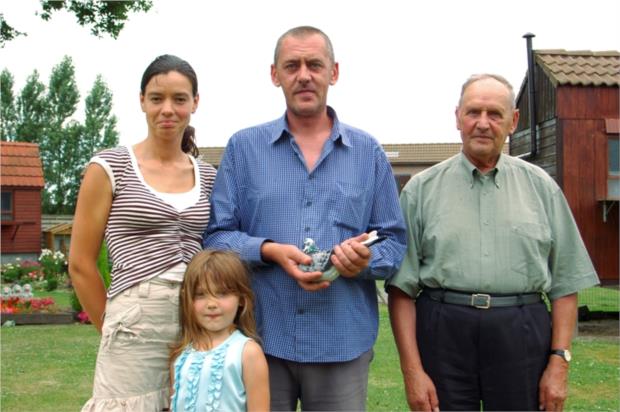
To the long-distance
Pol Bostyn died in 1985 and his pigeons were dispersed all over the world. The end of an era, also for Luc Sioen. Luc returned after his military service and started to race together with his father. Luc wished to take up long-distance racing and Gerard let him do what he wanted. They bought some pigeons from Herman Callebert, but -we already mentioned it before- father Sioen’s own breed performed very well on the long-distance as well. In the meantime, Luc still kept up his network of Belgian and foreign contacts, and through these, he sometimes acted as middleman in transactions of pigeons to other countries. One of the contacts that he still had from his time with Bostyn was the Taiwanese Deng Fu Chuang. Deng Fu was an ambitious businessman who planned to start racing in Belgium, and preferably to achieve world famous results from Barcelona. He knew the young Sioen and discussed his plans with him. Money was apparently no problem for Deng Fu Chuang, and he wanted nothing but the very best. Together they would storm the international podium of Barcelona…
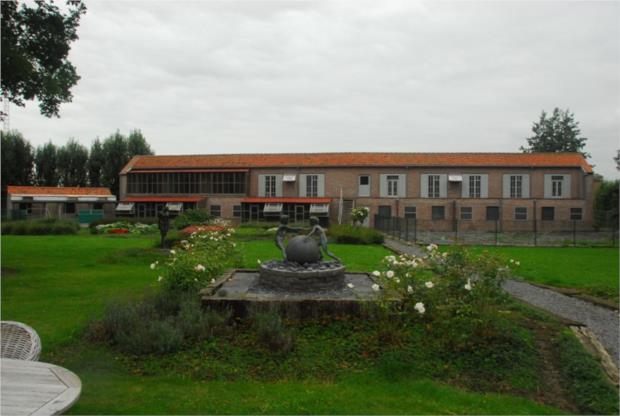
Great Wall
In 1992 it was a fact: the combination Deng Fu Chuang & Luc Sioen was a reality under the nice sounding name of ‘International Lofts Great Wall’. A gigantic loft was built on the premises of the family Sioen: a brickwork loft with two stories, about 35 meters long with 10 spacious racing compartments. There was space enough since the flax production was ended and the barns and the flax factory had been demolished. The only things still missing were the pigeons.
Once again, Luc Sioen’s good contacts in the pigeon world proved very useful. The duo wanted nothing but the very best pigeons in their loft, which meant national and even better international winners, national ace pigeons or pigeons that were of world class otherwise. It would be too much to name all the pigeons that passed by, but there were a great many of them.
A selection:
– ‘Speeltie’, DV8759-291-90, 1st international Pau against 6,875 pigeons in 1992 for Klaus Schmitt. And they bought the parents as well…
– ‘Margriet’, DV6055-200-87, 1st international Pau against 5,927 pigeons in 1990
– ‘Barcelona Brasse’, NL2012144-89, 3rd international Barcelona against 27,108 pigeons in 1992, + his nest sister and his parents, and in the end the entire loft Brasse (mainly Stichelbaut and Van der Wegen)
– ‘Cobbe’, NL2842534-91, 1st national Dax against 36,861 pigeons in 1992 for John Crombach, Kerkrade
– ‘Commer’, 3210906-85, 2nd international Barcelona against 21,736 pigeons in 1987 for Gerard Decommere
– ‘Bardinos’, NL1052186-88, 1st national Ace pigeon long-distance NPO in 1990 and Olympiad Verona
– ‘Tonsing’, NL5747846-87, 1st national Ace pigeon long-distance NPO in 1989, 3rd national Perpignan for Jan Cobben
– ‘Tiger’, NL1108985-87, 2nd national Ace pigeon long-distance NPO in 1991, 3rd national Bergerac
– ‘Brecht’, 2555150-88,1st national Ace pigeon from Remi Hoebrechts with 4th semi national Brive against 1,909 pigeons, 25th national Barcelona against 11,399 pigeons and 29th national Perpignan against 6,103 pigeons, all in 1992
– Children out of ‘Orhan’ and ‘Myra’, the very best of the Brugemann Bros from Assendelft
– And of course ‘Rikkie’, NL1164925-90, 1st international Barcelona against 33,196 pigeons in 1993 from Jan Theelen.
Contrary to what you might think, dear reader, it was not their intention to create a luxury breeding station. The intention was in the first place sporting: excelling on the hardest distances. For Deng Fu it was also a matter of prestige. With (photographs of) these pigeons and that installation you can easily impress friends and competitors at home. Now the results only had to start rolling in…
Good but not good enough
Because their goal was the extra long-distance they had to practice patience for a few years, and it was only in 1995 that they could start seriously with a team of second-year pigeons. The results were there, but actually not so overwhelming as hoped and dreamed of beforehand. They had good results with all that illustrious power: on a regular basis top 20 or top 30 national, twice with the national champions KBDB extra long-distance (among others 8th national Champion long-distance in 1998), 4th in the West European Super Marathon, 7th European Champion ZLU and a few other nice classifications. For instance the ‘Broere’, ring number 3121305-93, a son of ‘Brecht’, became 8th international ace pigeon Barcelona for four years (1995-1998) and in 2000, 6th Primus inter Pares BBC and so on. But nevertheless, both Luc Sioen and his Taiwanese partner were not entirely satisfied. After all the results were not so spectacular that they stormed the national and international podiums: good but not good enough. It was a bit like our Belgian football team: a collection of world-class superstars but who are not achieving the amazing results that everybody hoped for… “I have thought about this a lot, or rather, worried about it… I lay awake at night over it…, searched for an explanation,” sighs Luc Sioen. “We have pampered these pigeons, looked after them and given them every chance, but I actually suspect that those breeding pigeons had never really felt happy with us. Call it the famous tree that you had better not uproot. After all, you move top pigeons hundreds of kilometers from their home, and put them in aviaries and breeding boxes. Wouldn’t you fret and pine for home yourself? I think that this has certainly been a factor that prevented the breeding form here…” And Luc substantiates this with a remarkable story: When Hein Brasse once visited us and went to say goodbye to his famous ‘Barcelona’, the bird started cooing and turning in its box… something he hadn’t done before at all in Moorslede. “The conclusion was clear,” Luc decides, “It isn’t enough to buy the best pigeons in the world and to put them all together to breed equally good winners out of them… Pigeon sport is not simply a mathematical equation…”
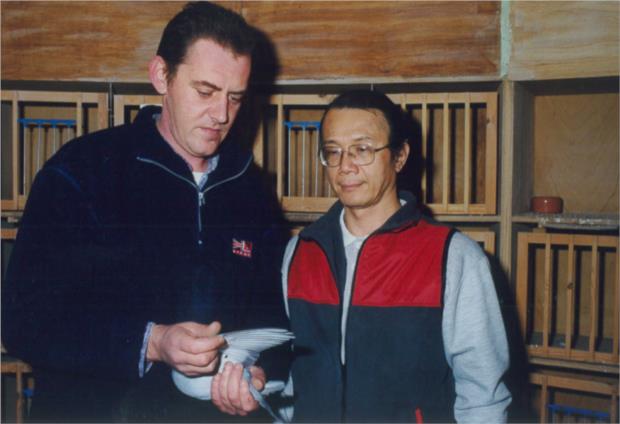
Luc Sioen with his Taiwanese partner Deng Fu Chuang. Together, they form the International Lofts Great Wall in Moorslede in 1992. The lofts were populated with the very best pigeons of the time…
Balance
After 10 years ‘International Lofts Great Wall’, the partners Luc Sioen and Deng Fu Chuang got together to make up the balance. In the end, only the ‘Rikkie’ and the ‘Brecht’ had achieved what they were bought for. For their own loft, the ‘Rik’ (3177088-95), a son of Brecht x Rikkie, flew 19th national Barcelona against 12,731 pigeons in 1997. The ‘Usie’, a hen out of brother Rik x daughter Tonsing won 1st national Pau hens in 1997 (6th international hens of 1,260 pigeons). That seemed like a good start, but the euphoria was short-lived. The combination Sioen-Deng Fu Chuang was certainly strong competitors, but they had not really realized the high set goals of 1992. And in the end, they decided to end their partnership on friendly terms. “I didn’t want to discuss and haggle a lot about who would keep what, and suggested that Deng Fu would keep all racers and breeders. Deng Fu had obviously nothing against this proposal, and the birds were moved to Taiwan. After this they didn’t have much contact and Luc Sioen doesn’t know what has become of these super pigeons. He had kept a small core of young out of the superstars for himself, and there were still a number of descendants of especially the ‘Brecht’ and the ‘Rikkie’ in the lofts of friends.
However, don’t think that there were no pigeons at Sioen’s home at all… During the entire period, Gerard Sioen had kept his own pigeons and been racing his own races with these. So Luc could effortlessly step back into the combination with his father. And -even more important- in the meantime Hilde had come on the scene and she had become a fancier herself, with her own loft from where she raced with young pigeons and hens. But that is another story that will be told in PART II.
The Luuszak
One of the better pigeons from Gerard and Luc Sioen in the ‘post Great Wall period’ was the ‘Luuszak’, 3028293-02. He was a son of the ‘Crayonne’ (in the pedigree altered into ‘Crionne’), 3177174-95, a grandson of the ‘Brecht’. The ‘Luuszak’ flew among others:
– 23rd national Pau against 2,212 pigeons in 2005
– 26th national Perpignan against 7,611 pigeons in 2005
– 30th national Pau in 2007
– 147th national Perpignan in 2006
By way of his father ‘Crayonne’, the ‘Luuszak’ is also half-brother of the ‘Goudklompje’, mother of ‘Il Grillo’, 1st international St. Vincent 2006 and grandmother of the ‘Fabian’. This ‘Fabian’, 3113064-06, won 1st provincial St. Vincent against 1,297 yearlings and 3rd international St. Vincent in 2007. The ‘Fabian’ was an inbred: his father ‘Fabio’ was a brother of the ‘Il Grillo’ and his mother ‘Wilma’ was a daughter of the ‘Crayonne’, and so half-sister of the ‘Luuszak’ and ‘Goudklompje’…
The ‘Crayonne’ himself flew in his active career:
– 91st national Montauban
– 97th national Pau
– 95th national Narbonne
The mother of the ‘Luuszak’ was the 3025047-99, who won 9th national Argenton in 2000. This Argenton hen came out of the 8th national Bourges 1998 (Decroix x Verheye) x daughter Generaal (1st national Cahors 1996 for Georges Bolle).
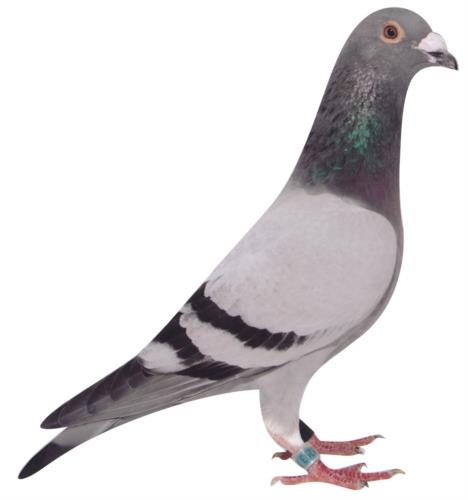
The ‘Luuszak’ 3028293-02
3rd National Ace pigeon Extra Long-distance for Luc and Gerard Sioen in 2005.
He won then 23rd national Pau against 2,212 pigeons and 26th national Perpignan against 7,611 pigeons. He got his not very flattering name because he was such a shy bird…
A bit of the history of a name
But where did that unusual name ‘Luuszak’ come from? ‘Luuszak’ is West Flemish for fleabag: a very unkempt person and therefore carrier of pests. There is also an interpretation of ‘lazybones’, but in my opinion this is wrongly derived from ‘lazy’ instead of ‘flea’. But when someone in the area of Roeselare calls you ‘a luuszak’ -and it isn’t said in jest- then I would not feel that as a compliment. It would have a meaning like, ‘good for nothing’, ‘vagabond’ or something. For that matter, that is also the description of this pigeon: an insufferable, wayward pigeon that rubs you up the wrong way, a bad pigeon. “The ‘Luuszak’ was an extremely shy bird,” Luc explains, “He could stay outside the whole day, just because he was afraid to drop down and come inside. Basically, a pigeon that could drive you insane on a day like that… but he was a super pigeon. With all his dithering and hesitation, he still managed to become 3rd national ace pigeon long-distance…”
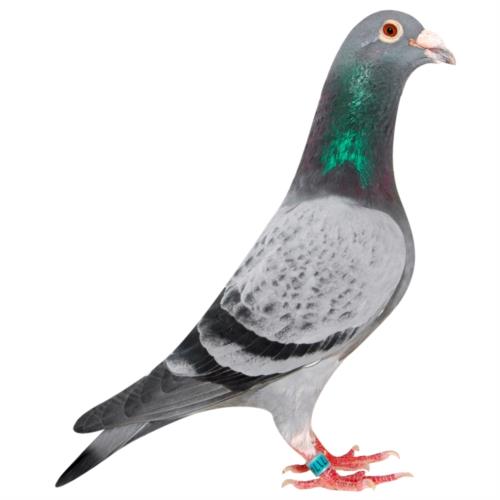
The ‘Crayonné’ 3177174-95
(or ‘Crionné’ if you prefer)
Grandson of the ‘Brecht’ and a top breeder with Luc Sioen. Father of the ‘Luuszak’, ‘Goudklompje’, and ‘Mister Mystery’ (himself grandfather of ‘Cow Girl’, 1st national Bourges for Rik Hermans)…
Fundamental error
Luc Sioen couldn’t have had a better pigeon than the ‘Luuszak’: he achieved high results on a regular basis and he had a super pedigree… And thus Luc developed a complete breeding program around the ‘Luuszak’ and his father the ‘Crayonne’. He dreamed of a close pigeon family, his own pigeon breed with the famous ‘Luuszak’ as a base pigeon. And basically that worked out fairly well. The only thing that Luc had underestimated was that the shyness of the ‘Luuszak’ would be genetically defined and would be inherited for generations. “Within a few years I had a whole colony of pigeons that didn’t conform. I want to spare you the stories of the times that I didn’t have a single pigeon back in the loft because they were too shy to drop down and enter the loft -God knows why- and that they unsettled the rest of the colony by their flapping around over the roof… It drove me insane…” There will come a time that Luc Sioen will make a stone of his heart and dispose of the complete ‘Luuszak family’: racers and breeders. Luc Sioen doesn’t like half measures…
Meanwhile
But in among all these unruly pigeons, there was still one super, the ‘Il Grillo’ (Italian for cricket and also the nickname of Paolo Bettini, who won the cycling world title in 2006), with ring number 3100035-05. In that same year 2006 the ‘Il Grillo’, and with him Luc Sioen, made the front page of the pigeon magazines by winning 1st international St. Vincent against 5,396 yearlings with two hours in the lead. The ‘Il Grillo’ was a grandson of the ‘Crayonne’ and therefore a nephew of the ‘Luuszak’. His mother was in fact a daughter of the ‘Crayonne’, coupled with a cock out of the loft from Hilde, who won 1st national La Souterraine in 1999. We will come back to that later. The father of the ‘Il Grillo’ had in him all the best of what remained of the Great Wall period, in particular the ‘Orhan 66’. This ‘Orhan 66’ came out of the ‘Rik’ (19th national Barcelona and before mentioned son Rikkie x Brecht) x a daughter of the ‘Orhan’ from the Brugemann Bros.
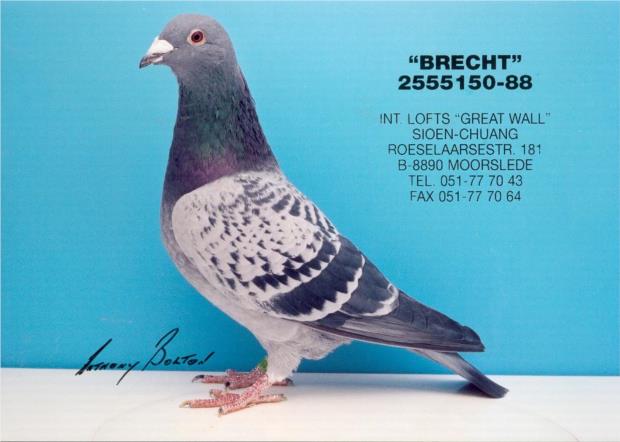
The wondrous ‘Brecht’ 2555150-88
from Remi Hoebrechts (Hoeleden)
The ‘Brecht’ became 1st national Ace pigeon 1992 extra long-distance with 25th national Barcelona and 29th national Perpignan.
That same year he also became 4th semi-national Brive.
Hoebrechts bred him out of the Gesteken Verbruggen (father 1st national Argenton) x the Gouden kweekduivin.
Purchased by Luc Sioen and Deng Fu Chuang and became a stock breeder there…
The offspring
All in all the offspring of ‘Brecht’ and ‘Rikkie’ was positive. For instance the ‘Brecht’ gave a few absolute toppers in following generations:
– 1st national Pau hens in 1997 (in their own loft with the ‘Usie’, granddaughter ‘Brecht’, ‘Rikkie’ and ‘Tonsing’)
– 1st international Dax 2006 (for D & D Platteeuw in Zillebeke)
– 1st international St. Vincent 2006 (before mentioned ‘Il Grillo’ for Luc Sioen himself)
– 1st national Barcelona 2005 (‘Queen Tonny’ for Bungeneers). The ‘Queen Tonny’ from Frans Bungeneers was a half Sioen, still from the period with Deng Fu. Mother of ‘Queen Tonny’ was a heavily inbred granddaughter of the ‘Brecht’. Which came about like this: In 1993, at the purchase of ‘Rikkie’, Luc had made firm contact with Jan Hermans, who in fact had bought the ‘Rikkie’ from his friend Jantje Theelen. Luc Sioen and Jan Hermans got on well together and over the years, this grew into a pleasant partnership and later a close friendship. Luc had, always looking for the best of the best for the Great Wall lofts, discovered that Jan Hermans had a direct daughter of the ‘Klamper’ from Cor de Heijde in his loft. “That is the pigeon for us,” Luc thought aloud. But Jan Hermans could not be persuaded: the ‘Briljantje’ was not for sale, not for any money. But between friends, another arrangement was made: Luc could borrow the ‘Briljantje’ for a couple of eggs with the ‘Brecht’. They produced a cock and a hen, ringed 3005218-98 and 219-98. Making sure to keep this bloodline, Luc Sioen coupled the two, nest brother against nest sister. And his hunch that this was extraordinary blood was further confirmed when pigeon specialist Frans Bungeneers praised the quality of the pair. Frans took a daughter of the inbred pair with him, and proved to be right by breeding the ‘Queen Tonny’ out of her. To be complete, we have to mention that the ‘Queen Tonny’ (named after the wife of Cor de Heijde) had a father as well, which was a direct Cor de Heijde out of the ‘Diamantje’ from Cor, an inbred Klamper hen.
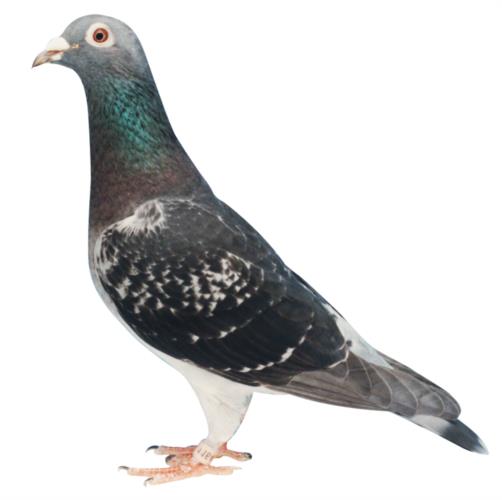
‘Rikkie’ NL90-1164925
was acquired from Jan Theelen by way of Jan Hermans after her resounding international victory on Barcelona against 33,196 competitors.
‘Rikkie’ came from Harry Bax (Heeze, the Netherlands) and had predominantly blood of the Kuypers Bros with a dash old sort Jan Theelen…
More offspring
Among others as a result of the national victory of Bungeneers, Cor de Heijde came to visit Moorslede. Cor also took a heavily inbred hen with him, this time out of ‘Orhan 66’ (who went on to become the father of ‘Il Grillo’) x his own sister. With Cor de Heijde this hen, 3100189-05, becomes his well known ‘Sioenduivin’. The ‘Sioenduivin’ came therefore out of the 3016166-01 x 3016144-01, both out of ‘Rik’ (19th national Barcelona and a son of Brecht x Rikkie) coupled to a daughter Orhan from the Brugemann Bros. Out of his ‘Sioenduivin’ coupled to a Son Perpignan, Cor de Heijde bred among others his ‘Naomi’, NL3054650-10, international ace pigeon Barcelona in 2013-2014 with 6th international Barcelona against 20,669 pigeons in 2014 and 72nd international from 25,294 pigeons in 2013. Furthermore you can still find top pigeons out of these famous bloodlines from Moorslede here and there. Rik Hermans for instance bred his ‘Cow Girl’, 6323201-09 (8th national Argenton and 1st national Bourges) out of a pigeon with 50% Sioen blood, and not just any blood… because the father of ‘Cow Girl’ comes out of ‘Mister Mystery’, a son of Crayonne (father ‘Luuszak’ remember?) x Fieneke 5000, the famous Olympiad pigeon from Flor Vervoort. Also the renowned ‘Schalie’ -in good Flemish dialect the ‘Schaljarden’- from John Bruneel was a half Sioen. The ‘Schalie’ flew 2nd national Agen against 5,507 pigeons (behind the ‘Fyther’ from Bert Van den Berghe) in 2013 and 1st national Libourne against 4,589 pigeons in 2014. His father still came out of a sister of ‘Il Grillo’, so purely out of the bloodlines ‘Rikkie’ and ‘Crayonne’. This same cock from Luc Sioen produced also the 6th national Perpignan in 2015 (also for Bruneel) and the ‘Pau’ (722/11), who won 11th national Pau in 2014 and 6th national Pau in 2013 for Johny Vanlerberghe. Not bad.
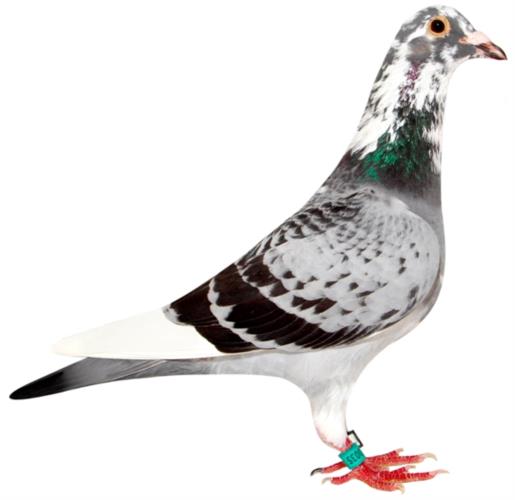
‘Il Grillo’ 3100035-05
Still had in him the blood of all important stock pigeons: ‘Brecht’, ‘Rikkie’ and ‘Crayonné’.
The colours come from the ‘Orhan’ of the Brugemann Bros.
He won 1st international St. Vincent against 5,396 yearlings in 2006.
For that matter, he is a nephew of the ‘Luuszak’…
New direction
Of course Luc Sioen is pleased that these famous bloodlines still surface now and then with top classifications, but he has stopped thinking about them a long time ago. Pau, Perpignan, Barcelona… he can’t get enthousiastic about these anymore. It is by now 2012. For several reasons Luc Sioen was totally cured from the ‘Barcelona mon amour’-syndrome. Almost all long-distance pigeons with a drop of blood from the ‘Luuszak’ were disposed of. Father Sioen had been dead for a few years, so it was time for a new era. It might have struck the reader that about every 10 years Luc Sioen changes to something completely different… 1992… 2002… 2012. Since a couple years Luc wants to ‘change the rifle to his other shoulder’ and to direct his energy towards the one-day long-distance with pigeons from his friend Georges Bolle. Besides that he wants most of all to enjoy the miracles that his wife Hilde conjures up with her hens on the long middle-distance… But that will be told in part II.
PART II: A ruthless selection is the best medicine
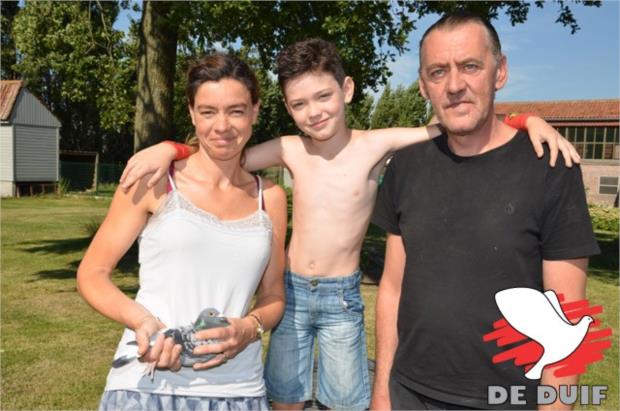
In part I you could read that up till now Luc Sioen has had an eventful pigeon career. This is only to be expected with a man as driven and no-nonsense. Luc doesn’t like compromise: it’s all or nothing. Luc believes that you have to keep both feet firmly on the ground as a pigeon fancier. If you set a goal, you’ve done everything possible to achieve that goal, but only half succeed, you must change directions completely. “Do what you have to do” he calls it. In part I you could read how Luc consequently did just that several times. Fortunately, in addition to Luc’s far-reaching experiments, there was always his father’s loft to fall back on.
On the whole of course, the balance was not at all negative: when you win 1st international St. Vincent, finish in the top 20 or top 30 nationally on the extra long-distance regularly, and classify in all prestigious national and international championships frequently, then that is not bad, not bad at all… But champion Luc Sioen still wanted something more, still wanted something better. And these surpassing successes came… but from a completely unexpected direction.
The arrival of Hilde
When Luc Sioen met Hilde, he told her tentatively that he was a pigeon fancier, and… that the pigeons were an important part of his life and that they took up a fair bit of time and attention. Although Hilde did not come from a pigeon fancying background, she saw no obstacles. On the contrary, the mystery of these wonderful birds that could find their way back home from hundreds of kilometers intrigued her. When she saw the pigeon installations for the first time, she was a little bit overwhelmed, but she quickly overcame this and before she knew it, she was involved in looking after the pigeons herself. She was also very supportive of Luc in everything that happened with the pigeons, but after a while, something was missing for her: she didn’t like the fact that she was looking after birds that she didn’t know and who might not even be there anymore the following week… lost during a flight, sold, selected out… Luc, who from young boy on had always wanted to be his own boss and go his own way, understood this perfectly. The solution was simple: they built a separate, smaller loft at the side of the big loft, from where Hilde could fly with young pigeons and later with hens. Luc knew very well that his long-distance pigeons were not suitable for these disciplines: these pigeons didn’t perform well as youngsters, and would be too slow for these kind of races. And thus it came about that, in 1998, Hilde started on her own -she could of course always rely on Luc and his father for help and advice- with young pigeons.
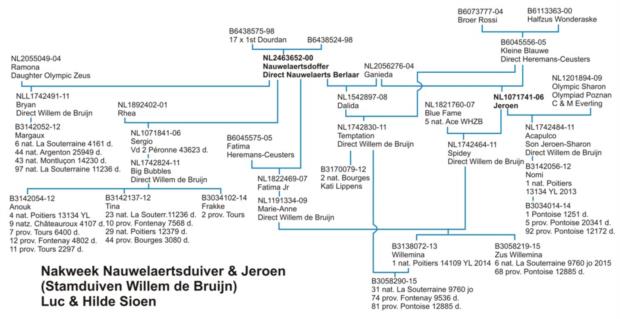
Sweet dreams
They bought an entire round of young pigeons from the ‘Dream Breed Lofts’ from Taveirne-Rigole from Koolskamp. These pigeons were all closely or distantly related to the super pigeons from the champions loft of Gust Taveirne and Frans Rigole (like the ‘Witslager Desender’, 3364845-70, national ace pigeon Long-distance 1975 with among others 3rd national St. Vincent and 5th national Cahors; the ‘Een-Witpen’ from Theo Marchand, 3079342-64, national ace pigeon Long-distance 1969 with 1st national Angouleme, 4th national Cahors, 11th national Bordeaux; the ‘Blauwen Angouleme’, 2085635-67 from Germain Imbrecht, Olympiad Dusseldorf with 2nd national Brive and 3rd national Barcelona and 4x top 10 provincial Angouleme; the ’76’ from Victor Torrekens, Olympiad pigeon with 1st Orleans against 1,177 pigeons, 1st Salbris against 1,194 pigeons, 1st Angouleme against 1,049 pigeons and much more).
Hilde started to care for them in her own unique way, and she was rewarded for it straight away. Her young team flew more than 50% prizes up to Tours, Blois, Chartres and La Souterraine. From La Souterraine, she won in the club against 196 young pigeons: 1, 4, 5, 7,15, 16, 17 and so on, with 18/28. What a start… The tone was set. But immediately this led to a problem: Hilde had intended to race with young pigeons, but pigeons that achieve so well as youngsters could hardly be disposed of… so they would also keep a compartment of yearlings. And it was here that Hilde and the people around her discovered her talents even better… The yearlings, and more specific the hens, were performing even better: 12/19 from Chateauroux, 6/9 from Bourges and 4 out of 4 from La Souterraine, including 1st and 10th national against 1,542 yearlings. The winning hen was ‘Miss La Souterraine, 3190101-98, a bird from the round of young from Taveirne-Rigole. You probably not have forgotten that ‘Miss La Souterraine’ afterwards became mother of ‘Goudklompje’, in her turn mother of ‘Il Grillo’ (1st international St. Vincent).
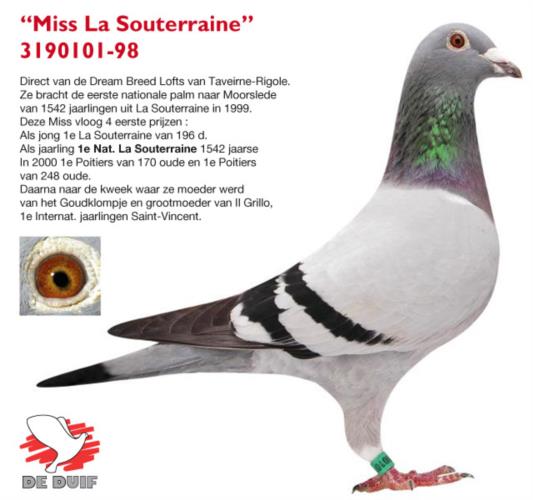
More Taveirne-Rigole
‘Miss La Souterraine’ was good publicity for the ‘Dream Breed Lofts’, and Gust and Frans were all too willing to house another round of young with Hilde and Luc in 1999 and 2000. And again, success followed. That Hilde was now pregnant with the first Sioen-child was not even a problem at first. In 2000, Indra Sioen was born, and racing with the middle-distance pigeons had to be reduced a bit. Although… In 2001, Hilde Vanoverschelde repeated her stunt from La Souterraine once more. A second national victory for the Sioen family was a fact. The winning hen got the name ‘Indira’, in honour of Indra Sioen, the daughter of Luc and Hilde who was born in 2000. The ‘Indira’ did not only win 1st national against 2,338 yearlings, she was also fastest of the entire field of 21,596 pigeons. Soon though, Hilde found that intensive pigeon sport and looking after a toddler are difficult to combine. And because Luc, nor Hilde like to do things by half, they decided to stop with the middle-distance for a while. We have said it before: in the Sioen family it’s all or nothing. Hilde still assisted Luc and Gerard when possible, but she didn’t have her own loft anymore… until 2011. In the meantime, in 2007, their son Cedric was born, and she had her hands more than full with the young family. But as soon as Cedric went to nursery school, Hilde’s hands started to itch. The loft was still there, the only thing missing were the pigeons. She didn’t have to tell Luc twice. He would take care of buying the right pigeons, and this time they would breed their own young.
Even more: they would build another loft, completely designed for racing with young pigeons. The model for this loft was the young pigeons loft from Kees Bosua and the one from Rik Hermans that already was a copy of the loft from Bosua.
Rik and Jan Hermans
It has already been written many times, that the best way to make a new start is with summer young or late young from two good performing lofts. This is what Luc and Hilde intended to do. The choice of the first loft was quickly made. When you can count Rik and Jan Hermans among your best friends, there is no better source for base stock. Rik, for that matter, was very successful that year: 1st national Bourges, 5th national Argenton, 9th national Bourges, 12th national Bourges and so on. And the years before: 2nd national Bourges, 3rd national Argenton, 6th national Chateauroux and more. The breeding loft of Jan and Rik -in which at that time Miel Van den Branden still played an active part- was populated with the best that there was to find in the Benelux countries for the middle-distance: two sons of the ‘Kannibaal’ from Dirk Van Dyck, Leo Heremans by way of Marina Vandevelde, still a Janssen hen of the old sort, the breed of ‘Fieneke 5000’ from Vervoort, Gerard Koopman, Kees Bosua, Rudy Diels, Bas and Gerard Verkerk and many others. In total 24 summer young from the team Hermans-Van den Branden came to Moorslede, in particular out of the line of the ‘Jaarling Dondersteen’ (grandson ‘Kannibaal’) and his fantastic breeding grandson, the ‘Propere’. A handful of these were trained, the rest were kept for breeding. And when Luc asked Jan from which loft he could best buy stock to cross with, the name Willem de Bruijn was the immediate answer.
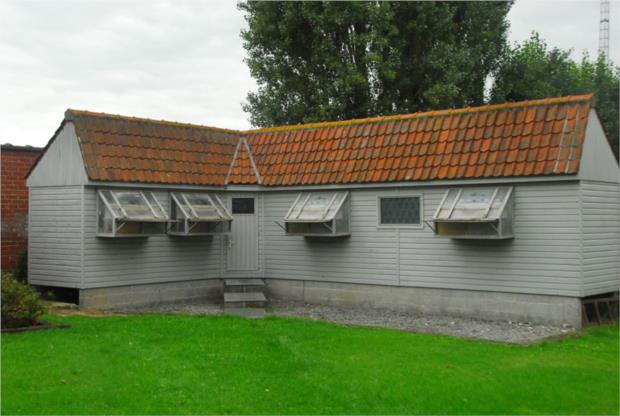
Hilde’s loft for hens. The long ‘leg’ of the ‘L’ contains two compartments for 16 hens each. The hens stay there he whole week, on perches in front of the closed nest boxes…
On to Reeuwijk
Supported by friend Jan, Luc asked Willem de Bruijn if he could buy a number of young out of his best pigeons. Of course this was possible, but Willem de Bruijn cautioned Luc Sioen to keep a healthy dose of realism: even out of the best pigeons there is no guarantee that you can breed good pigeons… Luc Sioen could live with this, because De Bruijn didn’t tell him anything new of course. They agreed on a price for eight young pigeons out of the best proven stock pigeons. Once the young were ready, Luc went to Reeuwijk to collect them. “As usual, I was welcomed warmly by Willem de Bruijn, but I got a shock when Willem pointed to a large basket with 24 young instead of 8… I was overwhelmed and told him that I didn’t have that much money on me…” Willem de Bruijn laughed and immediately reassured Luc: “You pay for 8 young as agreed, and the rest I give you as guarantee. I definitely want you to be successful with my pigeons and therefore I have put one young out of all my good couples into the basket. With 24 there is more chance that there is a good one among them than with 8…” For a moment, Luc Sioen didn’t know what to say, and then he thanked Willem heartily. Talk about a windfall. But the real windfall would show when Luc started to breed with these pigeons. Because you’ve got to understand: Hilde races with the pigeons, but it’s Luc who breeds them for her. Or more accurately, Luc decides on the breeding strategy, but it is friend Yves Vandecapelle who takes very meticulous care of the breeding loft. So let’s say it here once more: “Thank you very, very much, Yves, for your tireless efforts!”
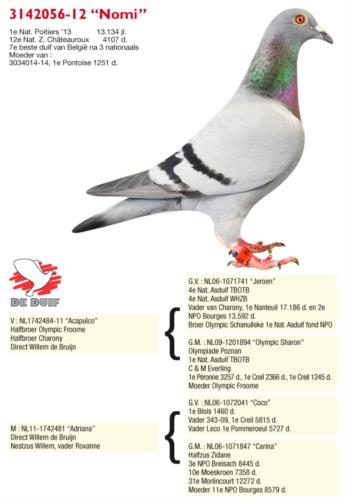
Free pairing
When the pigeons were ready, they were divided over two breeding lofts, taking great care that brother and sister didn’t go into the same loft. It was, after all, their intention to let the breeders form spontaneous pairs. The inspiration for this came from the experience that pigeons that are not happy will not give good offspring and sometimes even breed reluctantly. The fates were with them, because just through what some people would call ‘affinity’, a super couple was formed, the cock ‘Explosief’ from Willem’s loft, a grandson of stock pigeon Apollo x hen ‘Gipsy’, a direct Jan and Rik Hermans, granddaughter of ‘Jaarling Dondersteen’. In the first generation, this couple produced ‘Andrea’, 5th national La Souterraine and in the second generation ‘Nairo’, 1st national La Souterraine and the ‘Xiao Li’, 3rd national La Souterraine, which is a good result. But we are getting ahead of ourselves. In principle, you could already talk about a super successful input… but that was only a fraction of the success that would come out of the collective input from the pigeons Hermans-De Bruijn.
Discovery-round in 2012
With the late young from 2011, they bred two rounds of young in 2012. They were trained extensively and it became a discovery-round for pigeons and fanciers alike. A few direct Rik Hermans’ had already been trained in 2011 and they were immediately showing their worth. For instance ‘Emilia’, 3088148-11, and full sister of ‘Ranomi’ with Rik Hermans, flew in two seasons: 3rd provincial Fontenay against 7,568 pigeons, 30th national Chateauroux against 15,902 pigeons, 119th national Bourges against 16,859 pigeons, 14th Montlucon against 588 pigeons, 17th provincial Fontenay against 6,144 pigeons, 27th national zone Chateauroux against 4,288 pigeons, 29th national zone Argenton against 2,650 pigeons, 64th national zone Bourges against 3,085 pigeons, 80th national zone Bourges against 5,193 pigeons and 20th provincial Tours against 2,155 pigeons. After this, she was put into the breeding loft, where she became mother of ‘Nairo’, 1st national La Souterraine in 2015. We will come back to this later. But also among the young that were bred out of the round of late youngsters from Willem and Rik, immediately there was one good pigeon, ‘Raffaela’, 3142012-12. ‘Raffaela’ came out of the before mentioned crossing De Bruijn x Hermans: Explosief x Gipsy, and we will come back to these later as well. ‘Raffaela’ flew in succession 1st and 2nd from Fontenay against 584 and 340 pigeons. After that, she put the icing on the cake with 1st provincial Brionne against 3,308 young pigeons. That was a welcome victory, because it was proof that they were doing the right thing with their new input. Further that year, ‘Raffaela’ also flew: 24th Argenton against 835 pigeons and 35th Blois against 944 pigeons. It was good to see that her full sister ‘Zirtaki’, 3142078-12, performed almost just as well: 6th and 7th in the same two Fontenay races against 584 and 340 pigeons and 40th from Blois against 944 pigeons. You could start believing that you had discovered a breeding couple… When, in 2013, that same duo won 1st and 7th from Orleans against 145 pigeons, and the nest sister from ‘Raffaela’ 30th national La Souterraine against 11,236 yearlings, this hope was even more reinforced. They quickly bred another pair out of Explosief x Gipsy, which would go into the breeding loft. We’re talking here about ‘Rigoberto’ and ‘Natalia’, ring numbers 3138175-13 and 176-13. This proved to be a very good decision, because they became father of the 1st national and mother of the 3rd national La Souterraine in 2015.
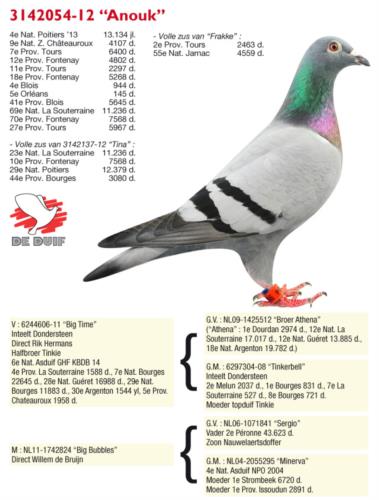
Fantastic 2013
Where 2012 was foremost a discovery-round with some very promising results, in 2013, the loft of Luc and Hilde Sioen was already going full speed ahead. Hilde had a round of young out of the Willem de Bruijn and Rik Hermans pigeons, and more than 19 yearling hens, plus four second-year direct Rik Hermans hens and a second-year hen from Rik Cools. In the club, the other members knew straight away that Luc and Hilde Sioen meant business. A few results to prove this are:
– Fontenay (301 kilometer) against 116 pigeons: 1-2-3-4-10 and further (10/19)
– Orleans (340 kilometer) against 145 pigeons: 1-3-4-5-7-10 and further (13/18)
– Fontenay against 376 pigeons: 2-3-5-7 and further (15/18)
– Fontenay (doubling) against 4,802 pigeons: 12-16-26-47 and further.
– Fontenay against 229 pigeons: 2-4-8-10 and further (10/13)
– Bourges (426 kilometer) against 267 pigeons: 2-13-21 (4/5)
– Chateauroux national (zone) (466 kilometer) against 4,107 pigeons: 5-9-11-12 and further (17/22)
To be complete: the 2nd prize out of Bourges was won by a hen from Eric Vermander. And among the pigeons there was also a champion from Rik Cools, ‘Kati’, 3088056-11. She won among others:
– 37th national Argenton against 12,187 pigeons
– 39th national Chateauroux against 17,984 pigeons
– 36th national La Souterraine against 9,545 pigeons
– 3rd provincial Montlucon against 2,609 pigeons
‘Kati’, for that matter, was not the only contribution from friend Rik. At Hilde and Luc’s restart Rik Cools had meticulously outlined to Hilde his system for racing with hens. We can therefore safely say that her method of racing with hens is almost a copy of Rik Cools in Ruiselede.
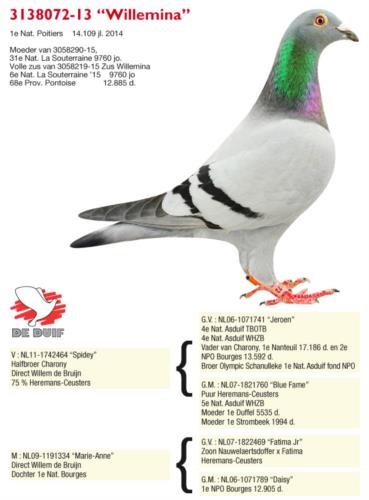
And then there was Poitiers…
For Poitiers the weather forecast, with north-easterly winds, was favourable for the west side. There were 12,984 yearlings in the competition, 27 of which from Hilde and Luc (among them a handful of long-distance pigeons from Luc). Because of the excellent results in the previous races expectations were high, but that they would become 1st and 4th national, even Hilde and Luc could never have dreamed. Five of their pigeons finished in the first 100 national against almost thirteen thousand birds. A dream result:
Poitiers National (520 kilometer) against 13,135 pigeons: 1-4-57-76-77 and further (17/27)
National winner was the blue hen ‘Nomi’, 3142056-12, a pure Willem de Bruijn. The week before, she had already finished 12th national zone Chateauroux against 4,107 pigeons, so it didn’t come as a complete surprise. She went in the basket as 4th nominated. After Poitiers, ‘Nomi’ stood 7th in the classification over 3 national races. Her father ‘Acapulco’ is a son of top breeder ‘Jeroen’ (4th national Ace pigeon and brother of ‘Olympic Schanulleke’) x ‘Olympic Sharon’ (Olympiad Poznan and mother of ‘Olympic Froome’). Mother of the ‘Nomi’ is ‘Adriana’, who comes out of Coco x Carina, both also top racers and proven breeders in Reeuwijk. ‘Nomi’ was put into the breeding loft and is by now mother of the 3034014-14, who flew:
– 1st Pontoise against 1,251 pigeons
– 5th provincial doubling against 20,341 pigeons
– 92nd provincial Pontoise against 12,172 pigeons
The second pigeon from Poitiers, that won 4th national, is ‘Anouk’, at that moment already a star in the loft with:
– 2nd Fontenay against 376 pigeons (provincial doubling 12/ 4,802 pigeons)
– 8th Fontenay against 229 pigeons
– 5th Orleans against 145 pigeons
– 9th national zone Chateauroux against 4,107 pigeons
– 4th national Poitiers against 12,984 pigeons
With this, she becomes 3rd provincial Ace pigeon GHF KBDB in 2013, with nationally 2nd best classed after two long middle-distance races. Understandably, she was put into the big basket as number 1. After her stunt from Poitiers, she was entered further with the results:
– 7th provincial Tours against 6,400 pigeons
– 18th provincial Fontenay against 5,268 pigeons
– 11th provincial Tours against 2,297 pigeons
– 4th Blois against 944 pigeons
– 69th national La Souterraine against 11,236 pigeons
– 70th provincial Fontenay against 7,568 pigeons
– 27th provincial Tours against 5,976 pigeons
– 8th Fontenay against 584 pigeons
The father of ‘Anouk’ is ‘Big Time’, a direct cock from Rik Hermans out of a brother Athena x Tinkerbell (and therefore half-brother of the phenomenon ‘Tinkie’ of Rik’s). Mother is ‘Big Bubbles’ from Willem de Bruijn, a granddaughter of his famous stock pigeon ‘Nauwelaertsdoffer’. That was the first champion that was bred out of the cross Hermans-De Bruijn, but it would certainly not be the last. Consequently, ‘Tina’, 3142137-12, a full sister of ‘Anouk’ won:
– 23rd national La Souterraine against 11,236 pigeons
– 10th provincial Fontenay against 7,568 pigeons
– 29th national Poitiers against 12,379 pigeons
– 44th provincial Bourges against 3,080 pigeons.
Further in 2013
That season, Hilde kept achieving with her hens in the same manner:
– Fontenay against 268 pigeons: 4-7-8-11-19-21-23-26-28 and further (11/15)
– Argenton (493 kilometer) against 483 pigeons: 2-3-4 (3/4)
– Argenton National zone against 2,650 pigeons: 29-50-52 (3/4)
– La Souterraine (531 kilometer) against 344 pigeons: 3-4-6-8-17 (9/10)
– La Souterraine national against 11,236 pigeons: 23-30-69-97…
– Tours (427 kilometer) against 208 pigeons: 2-3-8-9-10 (10/16)
– Tours provincial against 2,297 pigeons: 11-15-64-71-73…
That year the restarters Luc and Hilde Sioen became 3rd in the Gouden Duif Competition and 7th national Champion KBDB Long-distance (with the remaining pigeons out of the long-distance loft from Luc). Another yearling that made hay in 2013 was ‘Roxanne’, 3142072-12, this time out of a cock from Willem de Bruijn x a hen from Rik Hermans. The cock was the ‘Willem’, nest brother of ‘Adriana’, the mother of ‘Nomi’. Mother was a full sister of ‘Minerva’, who for Rik Hermans flew:
– 10th national Gueret against 13,885 pigeons
– 21st national Argenton against 22,442 pigeons
– 36th national Argenton against 4,123 pigeons
As a youngster ‘Roxanne’ flew 406th national Argenton against 25,949 young pigeons, but showed to be a real champion as a yearling:
– 16th provincial Fontenay against 4,802 pigeons
– 5th national zone Chateauroux against 4,107 pigeons
– 57th national Poitiers against 13,135 pigeons
In 2014, she went on to win 54th national Poitiers against 12,379 pigeons. This brings us to 2014.
More of the same in 2014
At the risk of becoming ‘boring’… 2014 was almost a copy of 2013, including a national victory from Poitiers. For the enthusiasts, a few of the results in 2014:
– Clermont against 255 old pigeons: 4-12 (2/2)
– Fontenay against 265 old pigeons: 1-28… (4/4)
– Tours against 504 old pigeons: 2-7-30-31-32… (12/20)
– Tours against 147 yearlings: 2-4-7-11-14… (9/9)
– Bourges against 340 old pigeons: 3-16… (9/16)
– Bourges against 202 yearlings: 3-7-9-10-14… (9/23)
– Fontenay against 182 old pigeons: 1-6-7-15-16… (6/6)
– Bourges provincial against 2,899 old pigeons: 43-63-64… (5/7)
– Bourges provincial against 3,324 yearlings: 36-79-120-121… (5/7)
– Chateauroux against 618 old pigeons: 1-7-33-59 (9/13)
– Chateauroux against 607 yearlings: 2-15-23-43-53 (9/21)
– Poitiers local against 521 yearlings: 1-4-10-34-58
– Poitiers national against 14,094 yearlings: 1-9-82-409-884 (7/10)
This time, the national victory was for ‘Willemina’, 3138072-13, a blue hen out of two direct Willem de Bruijns. ‘Willemina’ managed to fly 13 minutes alone in the lead during difficult, but fair pigeon weather. Not an everyday occurrence! Not surprising, she became effortlessly fastest of the whole field of 26,486 pigeons. Her father is ‘Spidey’, again a son of ‘Jeroen’ (through which ‘Nomi’ and ‘Willemina’ are nieces). Mother is ‘Marie-Anne’, once again a granddaughter of the ‘Nauwelaertsdoffer’. Just like her niece ‘Nomi’, ‘Willemina’ is already producing good offspring and mother of the 3058290-15, who as youngster won:
– 31st national La Souterraine against 9,760 pigeons
– 74th provincial Fontenay against 9,536 pigeons
– 81st provincial Pontoise against 12,885 pigeons
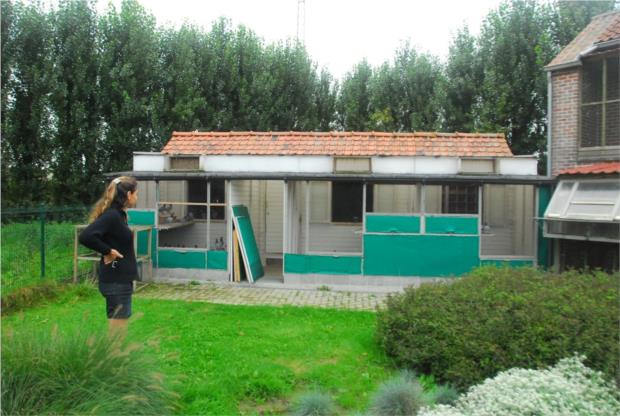
The loft for the young pigeons, modelled on the lofts of Kees Bosua and Rik Hermans. To the right, two compartments for the young pigeons that are raced with the sliding door method, to the left space for a smaller second round. Everything can be protected by green wind mesh…
La Souterraine twice bingo
For those of you who thought that the stunt of Hilde’s from Poitiers in 2013 and 2014 was already the maximum, we can now go one step better. During 2015, Luc and Hilde seem to have spared all their strength for the two nationals from La Souterraine. In the three categories combined, they won 1, 2, 4, 5, 6 and 7th national. Let’s put them in order for you:
La Souterraine I (July 6th):
Against 6,205 yearlings: 4-5-118-221… (9/10)
– ‘Xiao Li’, 3034163-14, 4th national
– ‘Andrea’, 3034025-14, 5th national
Against 4,161 old pigeons: 2-7-58-64-101… (9/10)
– ‘Alexia’, 3138081-13, 2nd national
– ‘Margaux’, 3142052-12, 7th national
La Souterraine II (August 22nd)
Against 9,760 young pigeons: 1-6-31-65-132-225… (10/24)
– ‘Nairo’, 3058337-15, 1st national
– ‘Zus Willemina’, 3058219-15, 6th national
We will spare you the detailed pedigrees of these six champions. Only this: it certainly stays in the family! Because ‘Nairo’ (out of ‘Rigoberto’) and ‘Xiao Li’ (out of ‘Natalia’) are grandchildren of the couple Explosief x Gipsy, while ‘Andrea’ is a direct out of the same couple. Refreshing the memory: out of this couple they had already bred ‘Zirtaki’, ‘Raffaela’ and her nest mate. We can safely begin to call this a super breeding pair. ‘Alexia’ is in her turn a niece from the same ‘Gipsy’. And that ‘Zus Willemina’ a sister is of ‘Willemina’, 1st national Poitiers 2014 and niece of ‘Nomi’, 1st national Poitiers 2013, speaks for itself.
We said it before: it stays in the family. And let’s not forget ‘Margaux’, another granddaughter of the ‘Nauwelaertsdoffer’ from Willem de Bruijn. This ‘Margaux’ was no novice either, and had already won a few good prizes. Besides her 7th national La Souterraine she also won:
– 44th national Argenton against 25,949 pigeons
– 43rd national Montlucon against 14,230 pigeons
– 97th national La Souterraine against 11,236 pigeons
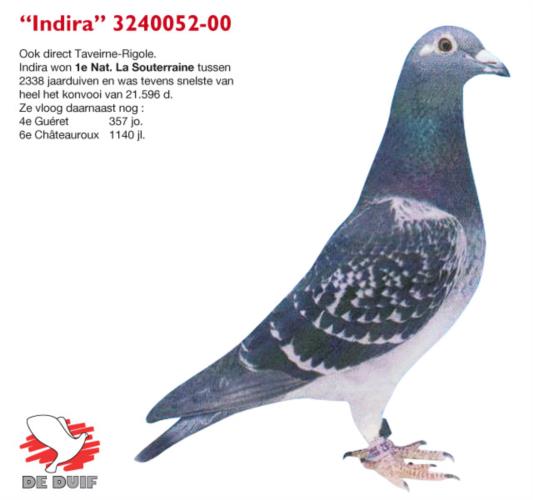
To be complete
A few more results in 2015:
– Clermont (177 kilometer) against 452 pigeons: 1-10-10… (10/14)
– Clermont against 414 pigeons: 1-11-15-18-19… (13/14)
– Fontenay (301 kilometer) against 362 pigeons: 3-4-6-7-10-11-13… (15/19)
– Fontenay against 201 pigeons: 1-2-6-7… (6/12)
– Fontenay against 365 pigeons: 10-17-36-38-39… (6/6)
– Tours (428 kilometer) against 418 pigeons: 1-3-4-5-9… (10/14)
– Tours provincial against 5,967 pigeons: 27-61-68-88…
– Tours against 269 old pigeons: 4-6-10-28-29-30… (7/8)
– Tours against 224 yearlings: 1-6-8-12-14-18… (11/14)
– Tours provincial against 2,463 yearlings: 2-65-88
– Limoges against 672 pigeons: 7-9-46… (6/7)
“As planned, after La Souterraine II, we closed the book on the 2015 season,” Luc Sioen says. “Besides, there was a lot going on as well and the pigeons were regularly disturbed or put into baskets… for photographs, for the doping control. Also, the season had been busy enough for us, and we wanted a few pigeon-free days with the children as well. But all in all, it was a fantastic finale of an unrivalled season.”
How does she do it?
I’m sure that you, dear reader, also ask yourself: ‘How does she do it?” Because let’s be clear about it: Luc Sioen admits without rancour that five of the six national victories at the Roeselaarsestraat 181 are entirely due to Hilde. That doesn’t mean that Luc does not have an active input in the strategy: together with Yves Vandecapelle he organizes the breeding program, plays his part in planning the racing program, helps thinking and searching for ways to keep the pigeons in good health… but the loft and the day to day care of the young pigeons and hens for the middle-distance, they are taboo for Luc. That is totally Hilde Vanoverschelde’s domain. We already said so in the introduction of Part I: Hilde has a feeling for pigeons that you can’t learn from books or magazines… and that you can’t explain or pass on to someone else. “So what is it that you do, Hilde, to make these pigeons so tame and affectionate?” we wanted to know. “You want to know?” she asked… “My pigeons are not tame at all. They are certainly not shy, understand me well, but they won’t come over to me, or sit on my arm or head. I’m not drilling them, if that was your question…” So what is it that she does do? “Observing, noticing everything, having a feel for the pigeon’s needs, be a pigeon among the pigeons, enjoying being with the pigeons, be consequent and consistent… I can’t explain it any other way…” Hilde tried to put it into words. “But that means that you have to spend the whole day with the pigeons?” we presume. Luc immediately contradicts us: “Looking after the pigeons takes a fair amount of time of course, think for instance about administering eye-drops or nose-drops, but Hilde certainly doesn’t live in the loft.”
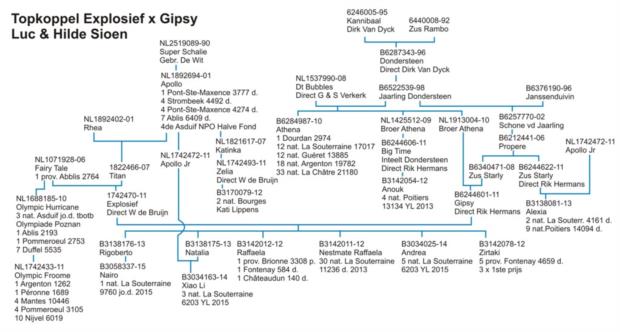
From anti to pro
This brings us to care taking and medical care of the pigeons. And here, Luc has his opinion ready. “The basis of our medical strategy is that, since a few years now, we avoid the use of antibiotics, almost banned them completely even. For over five years, we haven’t given anything against trichomonas… We also never go to a vet anymore so, basically, we don’t even know if our pigeons have tricho… but if their form is as it is, they can’t be all that sick.” As an alternative to antibiotics, a lot of probiotics are given, to support the immune system and intestinal bacteria with healthy bacteria cultures. During the racing season, from the start of the middle-distance, every week the pigeons get Probac-1000 over the feed for two days, in combination with oregano oil and two days Probac Energy in combination with lecithin oil (all products from Dr. Brockamp). Combined with the yellow drops, it seems that we stay on top of most illnesses and infections. “And what if the pigeons do get sick?” we ask cautiously… “That of course depends: a pigeon that has proven itself, we won’t dispose of immediately because it has a wet nose or a wet eye, but basically, we almost never have that problem because we are ruthless with the young pigeons. Weak birds (male and female) are weeded out straight away, and then there are almost never any problems with the older pigeons.” And Hilde continued: “This year, we have even gone a step further… I started 2015 with 55 young out of the first breeding round. Every time I detected a pigeon that looked a bit off colour or that was moping, it got a pink clip-ring on its leg. That means that that young gets five days to overcome its problems, without medication or extra help. If it doesn’t recover, the bird is removed, without looking at its pedigree… I can assure you that my heart sometimes bled, since because of this, in the end I started the racing season with some 25 youngsters (of the 55).” “Are you serious?” we ask incredulously. “That’s how it was,” Luc confirmed in his turn. “But…” he continued and Hilde agreed, “After that we have practically not lost a single young pigeon.” Could it then after all be true that you don’t easily lose naturally healthy pigeons? It’s certainly drastic and Spartan, but it appears to be effective as well when you see the achievements of these pigeons. Luc and Hilde believe that there’s not much chance that they kill a super pigeon, they are very rare anyway. “When there are a dozen good, usable pigeons in among a round of 50 young, you are lucky. The chance that there is a star among the weaker birds is almost non existent, we think. Hence our motto that a sharp knife is the best medicine.” Luc Sioen summarized their vision on medication with a brainteaser: “to give antibiotics means undermining the healthy pigeons in order to help -temporarily- the sick bird… So in the end, what have you won?”
Breath enough
“Can you tell me a bit more about the yellow drops? It seems that everybody is giving those nowadays…” “The yellow drops are indeed very popular, and therefore for sale everywhere (Koehoorn, Raf Herbots, Colman…), this after they had been out of use for a decade or more and been replaced by an uncontrolled use of antibiotics and ronidazoles. Colman Laboratories introduced the product about half a century ago as a disinfectant against among others trichomonas and mucous under the name of Mugomorve (now Mugmo). The active ingredient is acriflavin (also: trypaflavin), a strong disinfectant. Everyone seems to have his own way of using it: individually in the mouth or in the nostrils, or collectively in the drinking water or over the feed. Because it is a strong (and slightly poisonous) disinfectant, too much is not a good idea. Acriflavin is irritating, so you have to be careful to keep it away from the pigeon’s eyes!” Luc and Hilde Sioen administer the drops in both nostrils, after the races when they take the partner away, and at the same time, the birds that stayed at home are disinfected. “Tell the reader that it leaves stains on clothing that can’t be washed out,” Hilde tells us as a concerned housewife. The Sioen family is convinced that disinfection of the mucous membranes in nose and throat after the race is useful. “But that is not all,” Luc Sioen goes on. “In addition, every Monday, we use Sliepzand with the racing pigeons. After all, we assume that pigeons that don’t have ‘breath’ enough, won’t fly well, won’t like flying and are flying slower because of it.” Sliepzand is another old-fashioned product (distributed by Dofo) that basically irritates the mucous membranes of nose and mouth, thereby stimulating the production of mucous and loosening undesired mucous. With every pigeon, Luc and Hilde remove this mucous with a cotton swab. “A lot of work,” Hilde says, “but after this, the palate clefts are completely open.” Luc Sioen doesn’t know what the exact formula of Sliepzand is, and he doesn’t have to, as long as it works. According to the omniscient Internet, Sliepzand is a mixture of Haarlemmer oil (which causes the turpentine smell) and ground white alum. Unnecessary, Luc adds again that the pigeons are very susceptible to infections of the mucous membranes of nose and throat: bacteria, viruses, mycoplasma… They cause blockages and swelling that we generally call head illnesses (wet eyes, film, blocked tear-duct, bonded palate cleft, dry mucous, one eye cold…). The environment also plays a part in this: too much light, not enough oxygen, draughts, over population, stress, and contact with sick pigeons in the basket… The Sioen family seems to have all this under control with cleaning the mucous membranes and with a precise ventilation policy. As soon as the weather changes, Hilde goes to her lofts to make the necessary adjustments: more open, less open, screening the aviaries of the young pigeons with more or less mesh… With the young pigeons, the air vents in the ceiling are mostly closed. It makes the loft relatively dark and, during the night, the window always stays open, but it is protected with a green draught screen. During darkening, enough oxygen is guaranteed through the air vents in the ceiling. A lot of thought has gone into it all that is clear.
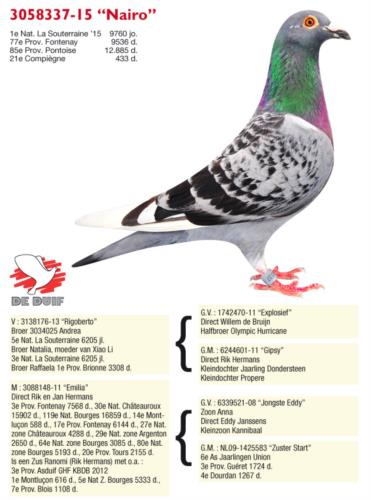
I am the boss
Who would think that Hilde spoils her pigeons, thinks wrong. “The pigeons have to know that I am the boss,” Hilde says, “a bit like ‘tough but fair’.” As soon as the pigeons have finished moulting, they are put on a very sparse winter regime. And this is the ideal time to teach them to listen. Hilde exercises her pigeons with a whistle. They are fed so little, that they rush helter-skelter into the loft at the first whistle, sometimes even through the door, to get to the feeder as quickly as they can. ‘Gone is gone’, they learn that very quickly. When they know the system of exercise, whistle and entering the loft, they are fed a bit more, but it stays sparse until they have twice been on a flight of 175 kilometers. During the racing season they are fed very lightly (low-protein) until the 300 kilometers. From 300 kilometers on, they are accustomed to a three-step feeding system: up to Monday recuperating with a low-protein mixture, Tuesday and Wednesday building up with a sport mixture and on Thursday repeatedly feeding without limits with a high-energy (read high-fat) mixture. The hens exercise twice a day for about half an hour, around 9 am and 4 pm. At the beginning of the season with use of the flag if necessary. In the morning, they are fed with barely a level spoon, and in the evening a full spoon per pigeon. Everything has to be eaten. At first, the young pigeons are not fed with a stepped system, because racing with young pigeons is not a priority. To grow well, young birds must eat especially good and varied for the first few months. In terms of supplements, the story is quickly told. On returning from a race, the pigeons get sedochol in the drinking water. Not much more is put into their water at any time. Pigeons must drink enough, is the view of the Sioen family, and they drink best from fresh, pure water. Over the feed we give predominantly probiotica, as we mentioned before: Sunday and Monday Probac-1000 in combination with oregano oil, and on Tuesday and Wednesday Probac Energy in combination with lecithin oil. On Thursday, the pigeons get pure food, so that they have no hesitation to eat. “We won’t say that our system is the one and only way to do things,” Luc Sioen finishes this topic, ‘in the past, we used to give the pigeons all kinds of other supplements and tonics as well. I’m not sure if it makes a difference or not… Healthy pigeons will thrive for the most part on healthy food alone.”
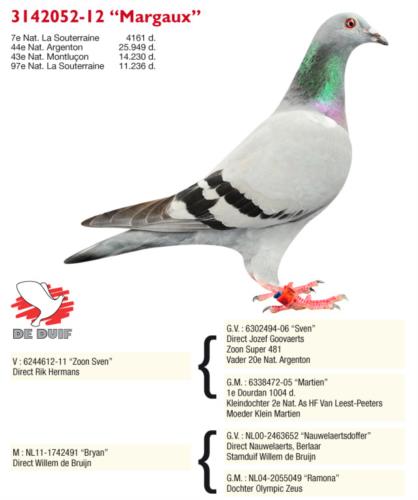
And what about Luc?
The reader could get the impression that Luc Sioen practices the pigeon sport mostly from the sidelines in Moorslede. But of course, nothing is more wrong. Although Luc has buried his ambitions and preference for the overnight long-distance, at heart, he remains a long-distance racer with a great respect for pigeons that can fly a few extra kilometers. We have already mentioned that Luc and Hilde became 3rd in the Gouden Duif Competition and 7th national Champion KBDB Long-distance in 2013. Naturally, this wasn’t achieved with Hilde’s middle-distance pigeons alone. Among the few remaining descendants of the ‘Luuszak’ -you’ll remember: those mostly shy birds- there were after all still a number of champions. For instance ‘Joachim’, 3026065-10, won:
– 13th national Cahors against 8,348 pigeons
– 52nd national Souillac against 5,282 pigeons
– 110th national Souillac against 7,760 pigeons
– 135th national Limoges against 14,271 pigeons
– 163rd national Libourne against 6,658 pigeons
His brother, the 3026080-10, won 7th national against 6,217 pigeons and 10th international Bordeaux of 11,444 pigeons. But eventually, Luc also got rid of these, and he started anew with pigeons from his friend Georges Bolle. In 2013, Georges Bolle said farewell to the pigeon sport as General Champion of the Entente. His age (78 years) and failing health made it necessary for him to sell his pigeons. Luc Sioen handled the sale, not forgetting to furbish his own breeding loft with the best that Georges had. Luc wants to breed with these Kapiteins, Generaals and Kolonels, to use them on the long-distance and… to cross them with the bloodlines of the pigeons with which Hilde dominates the middle-distance. As an experiment, Luc took over a few promising young cocks from Hilde. He put them in the widowers loft to race long-distance with them, and guess what… these pigeons can apparently handle that discipline as well. For instance ‘Vazil’, 3034061-14, (out of NL1742464-11 ‘Spidey’, father ‘Willemina’ x NL1742491-11 ‘Bryan’, mother ‘Margaux’) won five prizes, among which two long-distance flights:
– 11th Fontenay against 414 pigeons
– 8th Tours against 224 pigeons
– 21st Chateauroux against 942 pigeons
But also:
– 3rd Brive against 315 pigeons
– 10th Limoges against 375 pigeons
‘Frakke’, 3034102-14, a full brother of ‘Anouk’ (the super champion with among others 4th national Poitiers against 13,134 yearlings, 9th national zone Chateauroux against 4,107 pigeons, 7th provincial Tours against 6,400 pigeons and more) won:
– 2nd provincial Tours against 2,463 pigeons
– 15th Fontenay against 414 pigeons
But also:
– 55th national Jarnac against 4,559 pigeons
“Talent seems to transcend the boundaries of the system,” Luc summarizes these feats of the fast pigeons from Rik and Willem.
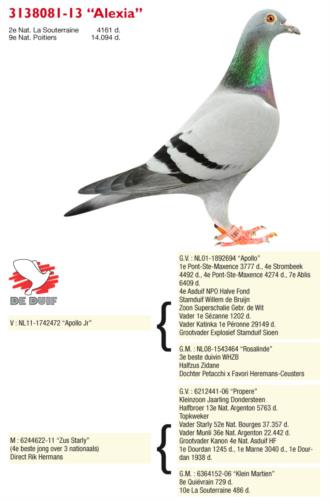
Because of the wind
“Luc, I’m not telling a secret if I say that some people call you a wind racer… When the westerly wind blows, your pigeons stay at home…” “Et alors (so what)…, would Mitterrand say, nationally, the middle-distance and even the long-distance is purely a wind game, non? With a headwind, you have no chance nationally. If we can’t win, we won’t participate, it’s as simple as that…” Luc Sioen doesn’t race for rankings or championships. This takes the pressure off to -against better judgement- participate for the necessary points or coefficients. “Look on the map at where we are situated in the west corner: with a westerly wind, we won’t have a chance nationally… And,” Luc Sioen defends his viewpoint, “we are surely not the only ones who take the actual chances into account… it can’t be coincidence that from La Souterraine I there were far fewer pigeons on the east side after they predicted hot weather and a north-easterly wind.” We counteract: “Wouldn’t it be better to abolish the national races altogether then? There is always a part of the country that has a disadvantage, or that has no chance at all, as you call it? “I wouldn’t go that far,” Luc answers, “the sporting image of a ‘national’ is very big abroad. For people who only know the Belgian pigeon sport through the written word and the Internet, a national victory says 100 times more than a provincial or zonal triumph. If you abolish that, you short change the Belgian pigeon sport, I think. Besides, the wind blows however it wants, and every region will have its turn.” “But even so, you abstain if you can’t win…” “Yes, but there is more to it than that…,” explains Luc Sioen. “Look, when our pigeons have to fly over Brussels coming home, they easily fly some 80 to 100 kilometers too far. That doesn’t do them any good you know, people forget that sometimes. They think that their pigeons flew a middle-distance race, but in the end, it was almost long-distance. And that is something else entirely. But actually, the primary reason to cry off with a westerly wind is that it makes the pigeons unsure. Pigeons that have had a couple of bad races because of the wind direction will lose their self-confidence. You can bet that the following race, they won’t be so eager to fly home. If you basket pigeons, of which you know in advance that they will fly the wrong direction, you basically learn them to fly the wrong line. At least, that’s my view on the matter, although I can’t prove it. But once again, I believe that pigeons that always come home following the ideal flight line will be more motivated to do their very best… And only with pigeons that are super confident, can you achieve the results like Hilde’s from La Souterraine.” Hilde keeps silent and just listens to Luc explaining his vision about the influence of the wind, which he has very likely already given dozens of times. And basically, we can’t say anything against it. Only participating on the middle-distance when you have a chance to win… et alors? There in Moorslede, they have done it five times already. So I would say, copy that.
Michel Bommerez
Extra:
1st & 2nd National Zone Chateauroux
1st & 2nd National Zone old pigeons La Souterraine
2nd & 7th National 4,129 old pigeons
1st & 2nd National Zone yearlings La Souterraine
4th & 5th National 6,116 yearlings
Moorslede, Belgium – Since their restart in the (long) middle-distance races, Luc and Hilde Sioen have already had several spectacular results, with as highlights 1st National Poitiers in both 2013 and 2014!
And this year their pigeons are in top form again, with weekly lead pigeons on the (long) middle-distance races, and with already many top prizes, starting with 1st and 2nd National Zone Chateauroux against 2,208 yearlings.
Zonal winning hen was the 14-118 ‘Roxy’, a hen out of the successful crossing Willem de Bruijn (son ‘Coco’ x ‘Carine’ and nest brother of mother ‘Nomi’, 1st national Poitiers 13,135 pigeons) x Rik Hermans (sister ‘Minerva’, 10-21 – 36th national). ‘Roxy’ is also a full sister of ‘Roxanne’ 12-072: 5th National Zone Chateauroux 4,107 pigeons… 54th National Poitiers 12,379 pigeons… 57th National Poitiers 13,135 pigeons… 16th Provincial Fontenay 4,802 pigeons and more.
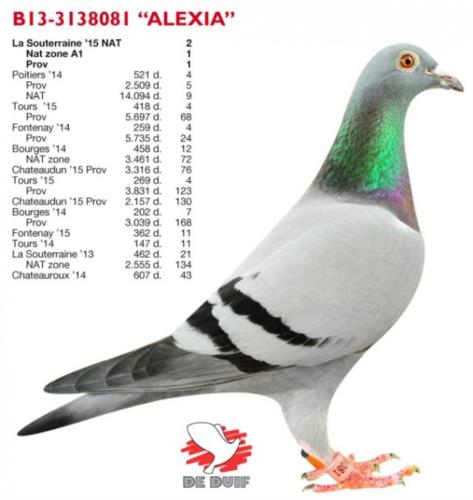
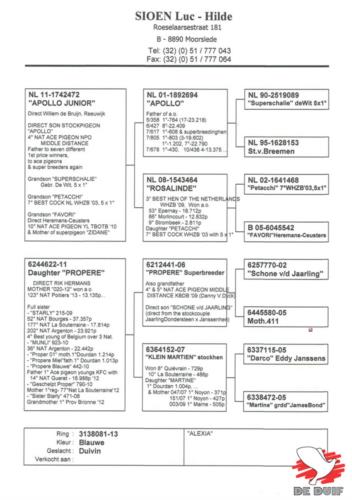
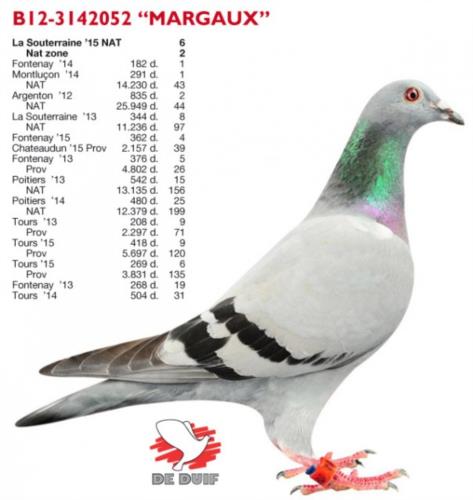
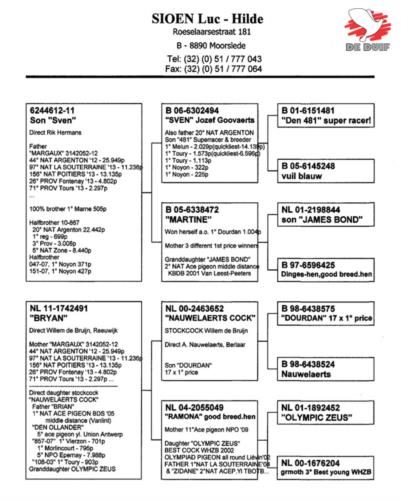
After the 1st and 2nd National Zone against 2,208 yearlings from Chateauroux on 22 June, Luc & Hilde did even better from La Souterraine. After having been in the basket for 4 nights, 10 old pigeons and 10 yearling hens defended the colours of this West-Flemish success formation. They went into the basket while in perfect form, and it seemed sure that they would deliver amazing results. And they did, because at 12.56 three pigeons arrived side by side over the lofts. With a breathtaking final rush, the ‘Alexia’ 081-03, previously already good for the 9th National Poitiers 2014 against 14,094 pigeons, and born out of ‘Appollo Junior’ from Willem de Bruijn x ‘Dochter Propere’ from Rik Hermans, beat her two yearling loft sisters ‘Xiaohi’ 163-14 (also out of ‘Appollo Junior’ now coupled to ‘Natalia’ (out of ‘Explosief’ from Willem de Bruijn x ‘Gipsy’ from Rik Hermans) and ‘Zus Rafaella’ 025-14, out of ‘Explosief’ from Willem de Bruijn (out of ‘Titan’ x ‘Fairytale’) x ‘Gipsy’ from Rik Hermans, out of ‘Broer Athena’ x ‘Zus Starly’ (= daughter ‘Propere’).
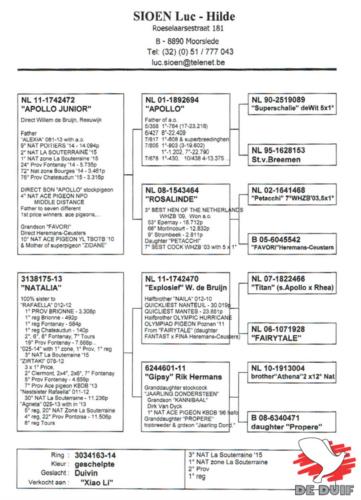
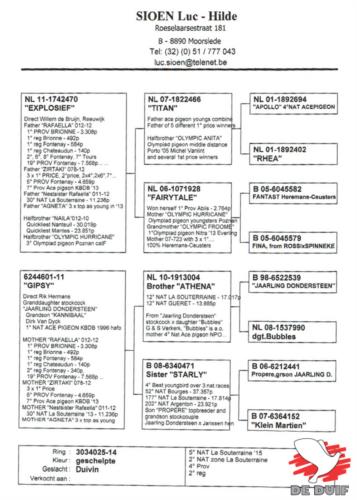
Barely 3 minutes later followed super hen ‘Margeaux’ 052-12 (out of ‘Zoon Sven’ from Rik Hermans x ‘Brian’ from Willem de Bruijn), who had previously starred with among others: 43rd National Montlucon 2014 against 14,230 pigeons, 44th National Argenton 2012 against 25,949 pigeons, 97th National La Souterraine 2013 against 11,236 pigeons.
In total, this means that Luc & Hilde Sioen clocked three pigeons within the seven fastest of a total of 10,245 pigeons.
A phenomenal achievement!
|